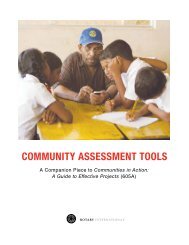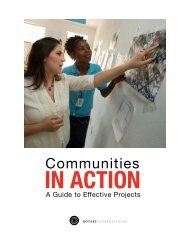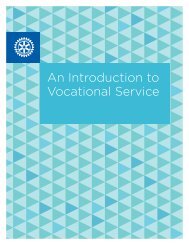BE A VIBRANT CLUB
Rotary International club leadership plan - asia
Rotary International club leadership plan - asia
Create successful ePaper yourself
Turn your PDF publications into a flip-book with our unique Google optimized e-Paper software.
245EN-J<br />
<strong>BE</strong> A<br />
<strong>VIBRANT</strong><br />
<strong>CLUB</strong><br />
YOUR <strong>CLUB</strong> LEADERSHIP PLAN<br />
ASIA<br />
JOIN LEADERS | EXCHANGE IDEAS | TAKE ACTION www.rotary.org
YOUR ROTARY <strong>CLUB</strong><br />
Is your club vibrant? Does it engage its<br />
members, conduct meaningful projects, and<br />
try new ideas? Your club’s activities should<br />
reflect the diversity and personality of its<br />
members. As you develop a plan for your<br />
club, use these tips and ideas, and be open<br />
to letting your club evolve. Remember, if<br />
you try something new and it doesn’t work,<br />
you can always try something else. Every<br />
member should feel empowered to<br />
shape your club’s future and make it<br />
outstanding.
MEET MY<br />
<strong>VIBRANT</strong> <strong>CLUB</strong><br />
The Rotary Club of Singapore was chartered in 1930 and<br />
currently has more than 120 members. Despite being a<br />
large and old club, we are not immune to membership<br />
challenges.<br />
Our board called a series of meetings to brainstorm<br />
ideas to better engage our members. As a result, several<br />
initiatives were put in place, and all were met with great<br />
enthusiasm by all our members.<br />
The first thing we did was make our weekly lunch<br />
meetings more exciting. Now we start with “Rotary<br />
Activity This Week,” a 10-minute slide show or<br />
presentation of all of the activities we are involved in.<br />
This includes Interact and Rotaract installations, overseas<br />
and local community projects, happenings at our service<br />
committee meetings, and our Rotarians’ presence at other<br />
events and in the media.<br />
Another thing we did was change our meeting format<br />
so that once a month our speaker is replaced by a handson<br />
activity, and once every quarter, our lunch meeting is<br />
replaced by a night meeting, featuring a marquee speaker.<br />
We have also increased our use of social media and other<br />
technology. Our club has an active Facebook page, with<br />
specific administrators who post pictures and news of<br />
Rotary events as quickly as possible, and a Club Directory<br />
app, which replaces our regular printed directory and<br />
allows real-time updating of members’ information.<br />
Since implementing these new ideas, involvement in our<br />
committees has increased by 15 percent, and our Facebook<br />
page visits have gone up by 5,000 percent. Innovation has<br />
been key to our member engagement.<br />
Dr. Shahul Hameed<br />
Rotary Club of Singapore<br />
Singapore
1<br />
Decide where your club wants to be in<br />
three to five years.<br />
Your club includes an array of community leaders who share a passion to<br />
make a positive impact. Together, decide what you want your club to be like in<br />
three to five years. Then determine what you need to do to attain your club’s<br />
vision. Your long-range goals should address your club’s membership, service<br />
projects, public image, leadership development, and involvement in The Rotary<br />
Foundation. Update your strategic plan as needed, and determine how all club<br />
members can contribute to achieving long-range goals.<br />
Resource on<br />
My Rotary:<br />
Strategic Planning Guide<br />
Ideas to try<br />
• Devote a month of club meetings to developing a strategic plan using the<br />
Strategic Planning Guide.<br />
• Hold a club meeting in a new location to inspire members to be creative and<br />
voice their opinions.<br />
• Develop a strategy for increasing member engagement over the next five years.<br />
2 Set annual goals and enter them into<br />
Resources on<br />
Rotary Club Central.<br />
My Rotary:<br />
Once you set your long-range goals, you’ll need to set annual goals that support<br />
them. Be sure your goals are achievable and measurable. Annual goals can<br />
be entered into Rotary Club Central, where they can be tracked and updated.<br />
Encourage all club members to view your club’s goals in Rotary Club Central<br />
and provide input. Update your goals regularly so Rotary Club Central always<br />
shows the most current information.<br />
Ideas to try<br />
• Focus on something your club is good at and make it something you’re great at.<br />
• Ask club committees to propose annual goals that address community needs.<br />
• Have a goal check-in on your meeting agenda once a month to update<br />
members.<br />
Rotary Club Central<br />
Rotary Club Central<br />
Resources course in the<br />
Learning Center<br />
All resources are available at www.rotary.org/myrotary.
3<br />
Hold club assemblies regularly to keep<br />
members engaged and knowledgeable.<br />
Club assemblies help all members feel connected. When all members have<br />
the opportunity to voice their ideas about club goals and activities, your club<br />
can maximise its collective expertise to address a local need. Many clubs use<br />
assemblies as a chance to inspire their members and fuel their shared passion<br />
to make a difference. An environment such as a club assembly that welcomes<br />
diverse perspectives is the perfect place to channel enthusiasm into action.<br />
Resources on<br />
My Rotary:<br />
Club President’s Manual<br />
Club Administration<br />
Committee Manual<br />
Ideas to try<br />
• Exchange club presidents with a nearby club for a meeting. After the<br />
exchange, schedule an assembly to talk about the experiences of the<br />
president and members.<br />
• Designate time in an assembly for new members to share their first<br />
impressions of the club and for members to share new ideas.<br />
• Once a month, include a 10-minute open forum at the end of a club meeting<br />
and encourage members to present new ideas or a topic for discussion.<br />
4<br />
Communicate openly in your club.<br />
Communication should go two ways in your club. Club leaders should<br />
be transparent in communications with members, and members should feel<br />
free to communicate openly with club leaders. Your communication plan<br />
should include relaying information at club meetings, on your club website, and<br />
through social media.<br />
Resource on<br />
My Rotary:<br />
Rotary Brand Center<br />
Ideas to try<br />
• Frequently update your club website and social media accounts; separate<br />
members-only information from information intended for the public.<br />
• Pair Internet-savvy members with those who are less experienced to help<br />
them navigate the website and social media.<br />
• Share information with members and check in regularly to see how members<br />
are feeling.
5<br />
Prepare members for future roles to<br />
maintain a smooth leadership transition.<br />
Annual leadership changes provide opportunities for members to take on<br />
new roles. It is helpful for members to understand the leadership roles and<br />
get involved early in the transition process. There are many ways to achieve<br />
continuity, including making appointments for multiple years; having a<br />
current, incoming, and past chair on each committee; and having the current<br />
club president work closely with the president-elect, president-nominee,<br />
and immediate past president. Thinking ahead will help ensure that there are<br />
enough volunteers to fill new leadership positions each year.<br />
Ideas to try<br />
• Have club leaders find their own successors during their terms of service.<br />
They are the most familiar with what the job requires and who would succeed<br />
in that role.<br />
• Learn more about members’ talents and interests, and assign them to roles<br />
they would enjoy and excel in.<br />
• Conduct on-the-job training for incoming club officers at least one month<br />
before they take office.<br />
Resources on<br />
My Rotary:<br />
Leadership Development:<br />
Your Guide to Starting a<br />
Program<br />
Club President’s Manual<br />
Club Secretary’s Manual<br />
Club Treasurer’s Manual<br />
Club Administration,<br />
Membership,<br />
Public Relations,<br />
Service Projects,<br />
and Rotary Foundation<br />
Committee Manuals<br />
6<br />
Adapt your club’s bylaws to support the<br />
way your club works.<br />
As your club evolves, so should your bylaws. The Recommended Rotary Club<br />
Bylaws are a starting point for outlining your club’s practices. Consider the<br />
recommended bylaws as a template that your club can edit and revise to reflect<br />
new practices and procedures.<br />
Resources on<br />
My Rotary:<br />
Recommended Rotary Club<br />
Bylaws<br />
Standard Rotary Club<br />
Constitution<br />
Ideas to try<br />
• Check that your club is using the latest version of the Recommended Rotary<br />
Club Bylaws.<br />
• Put your club’s bylaws on your club website or distribute them at club<br />
assemblies so members can offer suggestions.<br />
• Review them once a year as a club and share them with new members.<br />
• Consider running pilot tests of new club procedures to see if they work before<br />
amending your bylaws.<br />
All resources are available at www.rotary.org/myrotary.
7<br />
Develop strong relationships within<br />
your club.<br />
Connect with other members in your club and find common interests.<br />
When you enjoy your Rotary club, you will likely stay involved. When families<br />
are invited to join club events, younger members are more likely to attend.<br />
Provide opportunities for club members to make connections with one<br />
another, especially when a new member joins the club.<br />
Ideas to try<br />
• Sit with different people at every meeting and get to know them better.<br />
• Consider forming a satellite club to meet the needs of members who<br />
commute or have young families.<br />
• Invite friends and families to meetings, service projects, and events. Show<br />
them how wonderful volunteering is, and encourage them to join or help out<br />
regularly.<br />
• Survey club members to find out what kinds of social events they would like<br />
to attend and days of the week and times that are convenient for them.<br />
Resources on<br />
My Rotary:<br />
Rotary Fellowships<br />
Handbook<br />
Rotarian Action Groups<br />
Convention registration at<br />
www.rotary.org/convention<br />
8<br />
Make sure all members are involved in<br />
activities that genuinely interest them.<br />
Rotarians join clubs to create a positive impact in their communities and<br />
to make new connections, and that’s why they stay. Club involvement keeps<br />
new and long-time members engaged. Active members feel ownership of and<br />
dedication to their clubs’ projects. Consider asking members to volunteer to<br />
support service projects and other club initiatives.<br />
Resources on<br />
My Rotary:<br />
Communities in Action<br />
Membership Assessment<br />
Tools<br />
Project Lifecycle Resources<br />
Ideas to try<br />
• Get new members involved early in meaningful ways. Find out why they<br />
joined the club, and ask them to take on roles or help with projects or events<br />
related to whatever convinced them to join.<br />
• Conduct a member interest survey, and use the results to plan projects and<br />
activities and to develop weekly programs.<br />
• Have members introduce themselves to the club, including information<br />
about their background, talents, and interests to make other members aware<br />
of the club’s talent pool.<br />
• Consider ways that members can learn and gain experience from club<br />
activities. These new experiences can translate into professional and<br />
personal development.
9<br />
Coach new and current members in leading.<br />
Rotary clubs are full of professionals and leaders. With extra training<br />
about Rotary and useful leadership skills, members will be well equipped to<br />
lead your club one day. Prepare future club leaders by providing an orientation<br />
for new members and leadership development opportunities for all members.<br />
Current club leaders should be sure to attend district training meetings and<br />
apply what they learn to their work in the club.<br />
Ideas to try<br />
• Appoint a club trainer or training committee to oversee the training plan for<br />
your club.<br />
• Let young and newer members take on leadership roles. They can apply their<br />
existing knowledge and experience while also honing skills for their careers.<br />
• Ask members what leadership skills they would like to learn.<br />
Resources on<br />
My Rotary:<br />
Connect for Good<br />
New member information<br />
Trainer’s Toolkit in the<br />
Learning Center<br />
New Member Orientation<br />
Leadership Development:<br />
Your Guide to Starting a<br />
Program<br />
10<br />
Create committees that are practical for<br />
your club.<br />
Your club should have committees that help the club run well. Recommended<br />
committees include:<br />
• Club administration<br />
• Membership<br />
• Public relations<br />
• Service projects<br />
• The Rotary Foundation<br />
Create other committees, such as Rotary grants or youth service, if you need to.<br />
Whichever committees you choose, they should help your club take action to<br />
achieve its goals.<br />
Resources on<br />
My Rotary:<br />
Club Committee Structure<br />
Club Administration,<br />
Membership,<br />
Public Relations,<br />
Service Projects,<br />
and Rotary Foundation<br />
Committee Manuals<br />
Ideas to try<br />
• Small clubs: Consider how you can combine the work of committees.<br />
• Large clubs: Create additional committees to get all members involved.<br />
245EN-J—(414)












